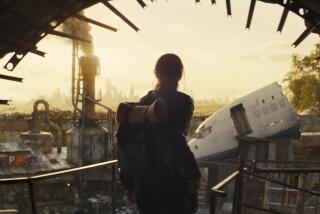‘Call of Duty: Modern Warfare’ adds a female Middle Eastern soldier’s POV. Here’s why
- Share via
If game writer Taylor Kurosaki has his way, this year’s annual “Call of Duty” release — a reset of the franchise’s “Modern Warfare” brand — will also reframe “Call of Duty’s” reputation.
While plenty have attempted to make a so-called thinking-person’s shooter, “Modern Warfare’s” single-player narrative, previewed for media in advance of this June’s Electronic Entertainment Expo, aims to capture the nuances of proxy warfare, a term used when outside powers fight one another through surrogates.
More intriguing — perhaps even risk-taking for a series known for its blunt patriotism — “Modern Warfare,” due Oct. 25 for the Xbox One, PlayStation 4 and PCs, gives players point-of-view control through a character named Farah Karim, a Middle Eastern woman and battle-scarred warrior who has been fighting for survival since childhood.
In one of the two missions previewed, we see Karim crawling under a bed and scurrying around her house to take down a lunkheaded Russian soldier with little more than a screwdriver.
ALSO: Disney’s Millennium Falcon — Smugglers Run is a fully realized ‘Star Wars’ toy »
“These people didn’t ask for the wars to be in their backyards,” says “Modern Warfare’s” Kurosaki, “and a lot of times they have no escape.”
Though set in the fictional Middle Eastern country of Urzikstan, the inspiration for a character such as Karim, says Kurosaki, was the very real YPJ, the female brigade of northern Syria’s Kurdish resistance militia that the U.S. has supported in its fight against Islamic State. There are plenty of Western hero-types in the game — this is “Call of Duty,” after all — but Kurosaki says his mission this time extended beyond blockbuster moments. He wants the “Call of Duty” fan to learn about a “side of warfare that they may not be aware of.”
“There’s this whole other side of war today that is real, that’s happening, and to ignore it or not cover it felt like it would be a terrible, terrible omission,” says Kurosaki, who joined “Modern Warfare” publisher Infinity Ward after years at Santa Monica’s Naughty Dog (“Uncharted’). “It wouldn’t be doing justice to the unintended victims in these wars and the unsung heroes of these wars.
“This game,” he continues, “is as much of an indictment of the industrial military complex of the superpowers of the world as it is a referendum on where you draw the line and what tips the scale from freedom fighter to terrorist. There are all these perspectives on this, and no one is completely innocent.”
It’s heady stuff, and while it will be a few months before we know if it will work, it’s also not necessarily what led “Call of Duty” to become one of the most recognizable names in gaming. Just a year ago, some were wondering if the Activision-published game would abandon the development of costly single player campaigns altogether to go multiplayer only, where persistent updates can extend the life of a game.
WHAT TO PLAY: The satiric ‘Shakedown: Hawaii’ and charmer ‘Escape Lala’ »
And while the franchise during its existence over a decade and a half has swung from world war realism to the occasional absurdity (astronaut soldiers), when it has tried to get thought-provokingly serious it hasn’t always worked. Case in point would be the second installment in the “Modern Warfare” series when an attempted commentary on terrorism allowed players to uncomfortably gun down civilians.
One of the previewed missions of the new “Modern Warfare” (this upcoming number-less release will be the fourth) sends players on an intensely intimate raid of a terrorist cell in London with returning British soldier Capt. John Price, a special forces expert. Gunfights will occur in narrow hallways of a multistoried home where it’s implied families live with the terrorists, and the line between civilian and enemy looks intentionally blurred.
In one moment, a woman is used as a human shield, but she ultimately turns out to attempt to attack the Western soldiers herself. It’s meant to be uncomfortable — there’s a baby to rescue in one room — and the gunfire and gag-inducing injuries become audibly graphic.
Kurosaki says he knows some scenes won’t be for the faint of heart.
“We want the players to obviously feel tension, and we want them to feel that there are stakes — there’s peril, frankly,” he says. “In the old games, Price always used to say, ‘Check your corners.’ I think you know what that means, but the player didn’t have to. It was window dressing. In this game, the player does need to check their corners; otherwise they jeopardize the mission.”
ALSO: How the ‘Avengers: Endgame’ video game crossover got a ‘Fortnite’ holdout to succumb »
Kurosaki says he wants “Call of Duty” to be spoken of as on par with the best war films, and he hopes “Modern Warfare” will inspire fans to check out the harrowing and eye-opening documentaries “The White Helmets” or “Last Man in Aleppo.”
It’s worth noting that some who worked on the Oscar-winning “The White Helmets” were barred entry into the U.S. due to travel restrictions by the Trump regime, highlighting the still fraught relationship America has with the region “Modern Warfare” will aim to shine a light on.
Thus, Kurosaki is certainly not unaware of the challenge that lies ahead.
“Typically, you can say ‘Call of Duty’ is the Walmart of video games. It’s this big behemoth,” he says.
“What would it mean if Walmart started to carry all organic produce? It would be such a big change,” noting that the mass market retailer would, in theory, be able to bring organics to the masses.
“So we have that kind of reach,” he says. “We touch all these people’s lives, and people love these games so much. So why can’t they get their wish fulfillment of navigating this complicated world and making a difference in it, and also learning about this whole other side of warfare?”
It’s a lofty and important goal, and while there have been independent games that deal with harsh, emotional realities of war — the anthology-like stories of 2016’s “Battlefield 1” went a more personal route —the rules are still being defined when it comes to marrying deep narratives with big-budget violent games.
“As a creator,” Kurosaki says, “I only get so many at-bats. It takes three years to make one of these games, and so you only get so many chances to say something. I would rather say something about making sense of the world that we live in today than not.”
More to Read
The biggest entertainment stories
Get our big stories about Hollywood, film, television, music, arts, culture and more right in your inbox as soon as they publish.
You may occasionally receive promotional content from the Los Angeles Times.











